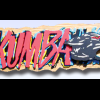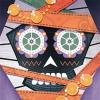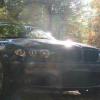RCT Discussion / 'Quarter Tile Style'
-
 05-March 05
05-March 05
-

 Lucifer
Offline
The RCT community has always found a lack of options and customability to be a problem, but it was always worked around, in the days of RCT: LL, Early days of RCT2, and now with the lack of options in RCT3.
Lucifer
Offline
The RCT community has always found a lack of options and customability to be a problem, but it was always worked around, in the days of RCT: LL, Early days of RCT2, and now with the lack of options in RCT3.
With the discovery of Custom scenery in RCT2, options were created and slowly the use of quarter tile objects became a style of Park making - Architecture, Foliage, in fact just about everything was able to be built with quarter tile objects, which allowed for a lot more detail. But I am just wondering - is there a limit to this?
Often you will see a 'quarter tile' park that is nothing more then an overwhelming wall of texture: no real architectural components, a mass of colour, and nothing that goes any deeper then looks. So - when is there to much detail?
Any opinions? -

 Kumba
Offline
Ever since the Object Editor came out I knew this whould make RCT2 the most detailed RCT game. Does it have limits? sorta, thats really a good question...
Kumba
Offline
Ever since the Object Editor came out I knew this whould make RCT2 the most detailed RCT game. Does it have limits? sorta, thats really a good question...
I think its clear Toon is the best with them coz he can custom make them and has awsome RCT skills. Its pretty ez to see he is just by looking at any of his work. Also id say Mala, leighx, X-Sector, and DJ are very good at the "Quarter Tile Style"
I also think we have yet to see the "best" of 1/4 work, witch mite come via IOA, PoD or from a park that does not come right to mind or has yet to be advertised. -

Kevin Offline
The 'quarter tile style' of parkmaking is probably the most common way to make parks these days.
Whether it is extremely detailed to the point where you can't even see a building, or it's just using quarter tile objects to accent a plain simple building, I prefer using the style that uses both sides.
I'm not sure how to explain this but...
I do beleive there is a limit to using quarter tiles. Some of you may think of Foozy's park, but I don't think that is the limit. His park just shows buildings with realistic structures and layouts with every building 100% different than the one next to it, instead of plain, simple 2x2 buildings with a few trees around it along with a whole area with pretty much the same stuff. I beleive thats why people think of his park as too detailed. They a see a collage of buildings that look so different from one another in colors and textures, but if you look at one building seperately its not that detailed...
But yes, I do beleive there is a limit, I just think no one has reached it yet. -

 Tech Artist
Offline
I think as long as you can use the "Quarter Tile Style" well, I don't think there is a limit of how detailed you can get before being too detailed.
Tech Artist
Offline
I think as long as you can use the "Quarter Tile Style" well, I don't think there is a limit of how detailed you can get before being too detailed. -

 Ride6
Offline
I think I'll paraphrase something Ed said a long time back. Extreme detail and very simple parks aren't as different as we would like to think. The detailed ones have so much detail that you can't comprehend all that's going on, be that stuff be stationary or in motion. In a simple park you comprehend all of what's going on because it's all presented in a straight forward way to the viewer. See?
Ride6
Offline
I think I'll paraphrase something Ed said a long time back. Extreme detail and very simple parks aren't as different as we would like to think. The detailed ones have so much detail that you can't comprehend all that's going on, be that stuff be stationary or in motion. In a simple park you comprehend all of what's going on because it's all presented in a straight forward way to the viewer. See?
There is a point where I believe it's no longer nessisary to continue to add detail. Foozy's park isn't quite the limit (imo) however it is quite close. You see, If everything is detailed that just becomes normal, there's no contrast and in my opinion it's contrast the makes great parks into legendary ones. Just look at Rift Valley if you don't believe me. There are all kinds of complex archetecture and theming elements however there are also areas of plain, open, grass. That's the beauty of it. The open grass is what in art terms could be considered "negitive space" and the buildings, rides, foldige or anything over the land (or water) could be considered "positive space". Spacing contrast is one thing that makes Rift Vally so stunning.
And just as I took negitive and positive spacing concepts from art you can apply additional terms to rct. Rythem could be applyed in how you place shrubs throughout a garden, in how you shape jagged rocks or even in how you apply details to archetecture. Rythem too is very important to the flow and feel of a park. Contrasting rythems creates more layers. Color, form, balance. It can all be applied to rct in one way or another.
As long as the way detail is acheaved is in an organized mass that could be recognizible as something familiar I would argue that there are no limits. Creating something that is familiar or comprehendible is a restriction itself however I would argue that is may be a nessisary one. If a 'park' was simply a mass of 1/4 tiles with no attempt at organization into a form then that's the point where it is no longer viable. As for making great parks we're roughly at the point where the level of detail is at it's resonible limit because there is a point that you can build the stuff that you can't really see most of what you've built. When you build buildings next to each other and you layer the tiles so that you completely hide one, then you've hidden some of what you have made. It's when you've hidden more of what you've made then you've allowed to show that you've gone beyond the reasonible limit. Nobody has done that I suspect that nobody soon will.
ride6 -

 Murdock
Offline
Murdock
Offline
Often you will see a 'quarter tile' park that is nothing more then an overwhelming wall of texture: no real architectural components, a mass of colour, and nothing that goes any deeper then looks. So - when is there to much detail?
*sign*
All these quarter objects are redundantly.
All the buildings have roofs, that even wouldn't have a cathedral.
You only look on the quarter tiles and not any longer on really good and interesting details. -

 Lucifer
Offline
Lucifer
Offline
I think we're surfing the same wavelength...[font="tahoma"]i find it absolutely terrible... and, ridiculous. not working.[/font]
 Tags
Tags
- No Tags
